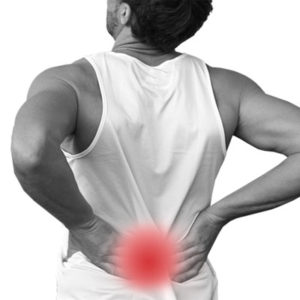
The Truth About Back Pain
Truth About Back Pain – A Musculoskeletal Health Survey Report
The Truth About Back Pain – The survey is based on the results of 953 people who completed the musculoskeletal risk factor profile.
First, here’s the profile used to measure the risk of musculoskeletal dysfunction. It’s easy to do and contains exercises that are familiar to people around the world.
The exercises we used in the survey are what you need to do to manage risk.
The Musculoskeletal Risk Factor Profile
Give yourself a score out of ten that is appropriate for your performance on the ten questions below. A good score is a high score. A bad score is a low score.
1. Current musculoskeletal condition
How would you rate the current condition of your musculoskeletal system?

2. Body composition
How close are you to your ideal weight?

3. Squat
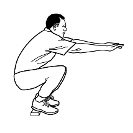 From a standing position, how many times can you squat down, with your backside as close to your heels as they will go, and stand up straight in 30 seconds? You may use a heel raise (as illustrated if you need to.)
From a standing position, how many times can you squat down, with your backside as close to your heels as they will go, and stand up straight in 30 seconds? You may use a heel raise (as illustrated if you need to.)
No. ……..

4. Abdominal strength
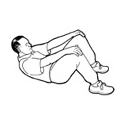 How many situps can you do in 30 seconds? Lie on your back with feet flat, knees bent at 90 degrees, and arms outstretched on your thighs. Sit up to touch the bottom of your kneecaps. Don’t count those situps where your fingers can’t reach the bottom of your kneecaps or your feet lift off the ground.
How many situps can you do in 30 seconds? Lie on your back with feet flat, knees bent at 90 degrees, and arms outstretched on your thighs. Sit up to touch the bottom of your kneecaps. Don’t count those situps where your fingers can’t reach the bottom of your kneecaps or your feet lift off the ground.
No. ……..

5. Upper body strength

How many press-ups can you do in 30 seconds, women on the knees and men on the toes? For women, make sure your knees, bottom, and shoulders are in a straight line; i.e., your backside shouldn’t stick up in the air. Don’t count those press-ups where the body flops onto the floor.
No. ……..

6. Flexibility
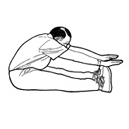 In a sitting position, with legs outstretched in front of you, see how far down past your toes you can reach with your fingers. Keep your knees straight. Score 4 if you can get your fingers to your toes (T), 5 for the first knuckle, 6 for the second and 7 if you can get to the palms (P). Score 10 if you can get your wrists past your toes (W).
In a sitting position, with legs outstretched in front of you, see how far down past your toes you can reach with your fingers. Keep your knees straight. Score 4 if you can get your fingers to your toes (T), 5 for the first knuckle, 6 for the second and 7 if you can get to the palms (P). Score 10 if you can get your wrists past your toes (W).
7. Functional mobility
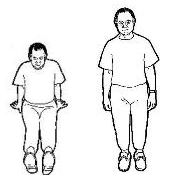 How many times can you sit down and stand up in 30 seconds? Start standing up with your legs straight. Sit down on the floor (legs straight out) and stand up.
How many times can you sit down and stand up in 30 seconds? Start standing up with your legs straight. Sit down on the floor (legs straight out) and stand up.
No. ……..

8. Shoulder function – wall test – a subjective assessment
 Stand with your back to the wall. Place your hands in the surrender position with your elbows, forearms, wrists, and fingers flat back on the wall. Score 10 if you can do this with ease. Score low if you have difficulty getting into this position or lower still if your elbows and wrists are far from the wall.
Stand with your back to the wall. Place your hands in the surrender position with your elbows, forearms, wrists, and fingers flat back on the wall. Score 10 if you can do this with ease. Score low if you have difficulty getting into this position or lower still if your elbows and wrists are far from the wall.

9. Strength training behaviour
Do you have a strength training program? No. of sessions per week

10. Flexibility training behaviour
Do you have a flexibility training program? No. of sessions per week


Your Risk Of musculoskeletal Function Is Assessed As: –
- Low: if you scored over 70
- Medium: if you scored between 50 and 70
- High: if you scored less than 50
If you score under 50, we suggest you attend the Crookback Clinic – or a yoga, tai chi, Pontius Pilates, Body Balance, Pump, or Complete Workout program three times a week. Do that, and your musculoskeletal system will be in good shape in a few months. You’ll feel the difference after a couple of weeks.
Now For The Truth About Back Pain
The results may shock you. Hopefully, they’ll galvanise you into action.
The Truth About Back Pain report provides compelling evidence that a strength and flexibility training program is necessary to avoid back, neck, and shoulder pain.
To put things in perspective.
Those Who Train
Not many people are doing any strength or flexibility training, but those that do feel better.
- Only 5% of people had a half-decent strength and flexibility training program, and their average total score on the profile was 84.
73% of these people gave themselves a score of 7 or more out of 10 for the current condition. - Only 17% of people had a reasonable strength training program. Their average total score on the profile was 74.
56% of people gave themselves a score of 7 or more out of 10 for the current condition. - Only 10% had a half-decent flexibility training program, but their average total score on the profile was 75.
55% of people gave themselves a score of 7 or more out of 10 for the current condition.
Those Who Don’t Train
The average total score of 57% of people with no strength or flexibility training program was a miserable 46. The average score for the current condition was 5.0.
Only 28% of people gave themselves a score of 7 or more out of 10 for the current condition.
It Sticks Out Like The Proverbial
The evidence is compelling. If you have a half-decent strength and flexibility training program, you dramatically reduce your risk of musculoskeletal dysfunction.
If you’re already dysfunctional, there is a good chance you’ll be able to restore poor function to good. Your pain will go away as your body gets more robust and back into better alignment.
Your pain is telling you to start training, not to go down to the doctor and the chemist.
You can close up all the musculoskeletal research institutes and put down the glasses. Just start training. You’ll get better.
What Sort Of Training Do I Need To Do?
Strength Training
You’ll need a general strength training program at the gym, like the one I’ve outlined in the Fix Back Pain ebook.
You’ll also need to do the four great strength exercises I recommend at home. They’re outlined in the ebook.
Flexibility Training
In the Global Back Care ebook series, I outline some key exercises you need to do to keep yourself in better alignment. Do that, and the pain goes away.
Regards and best wishes
John Miller
